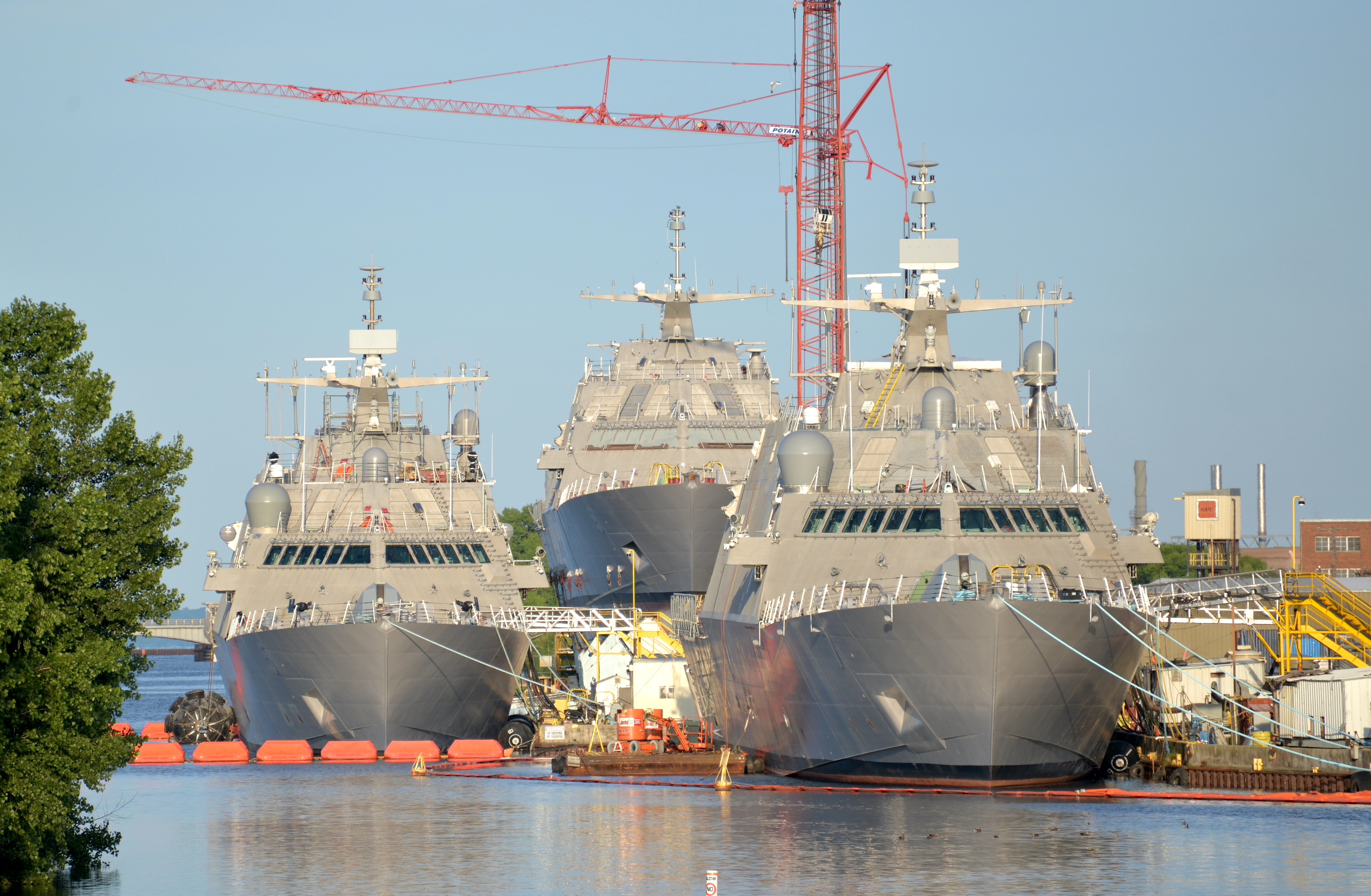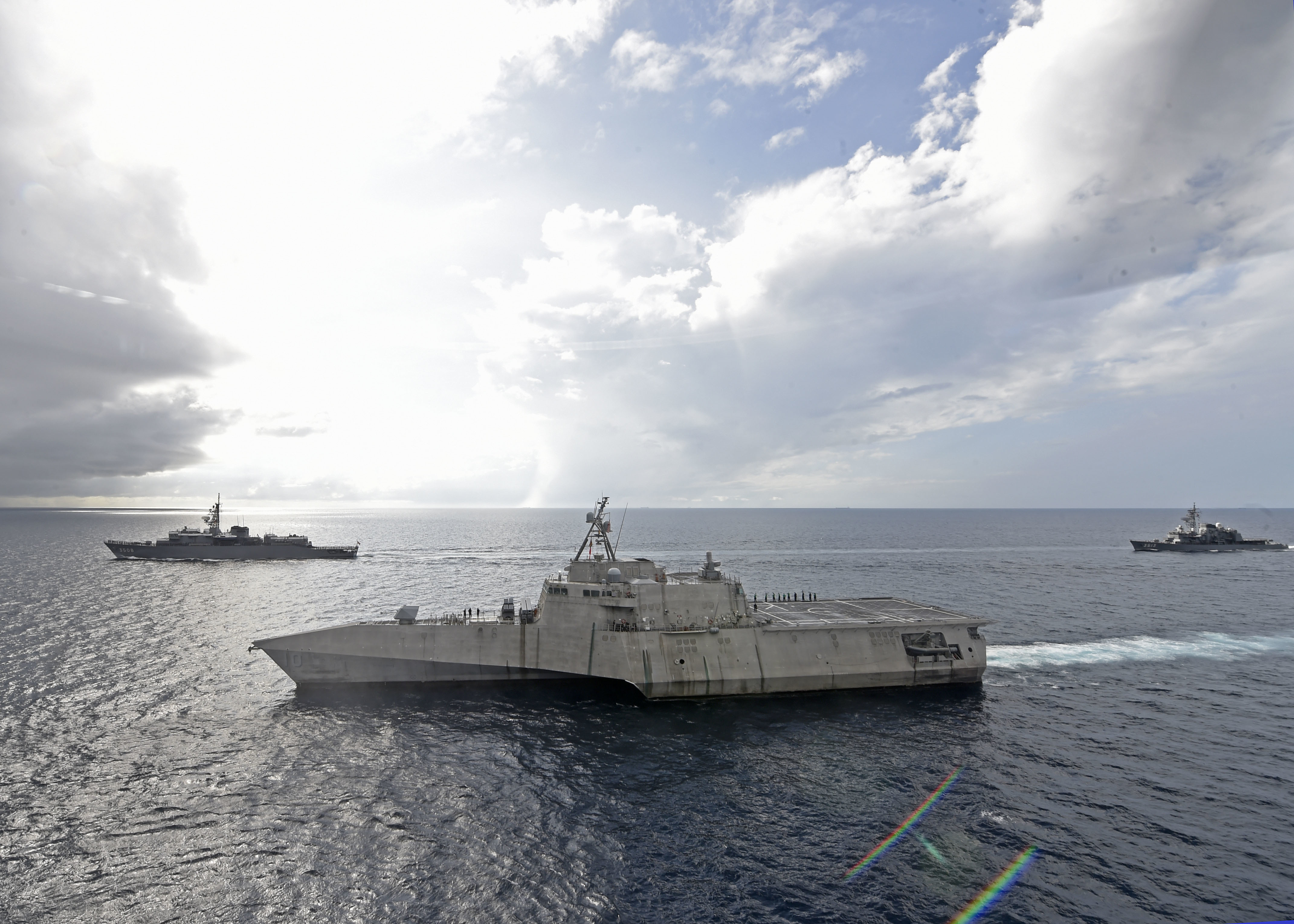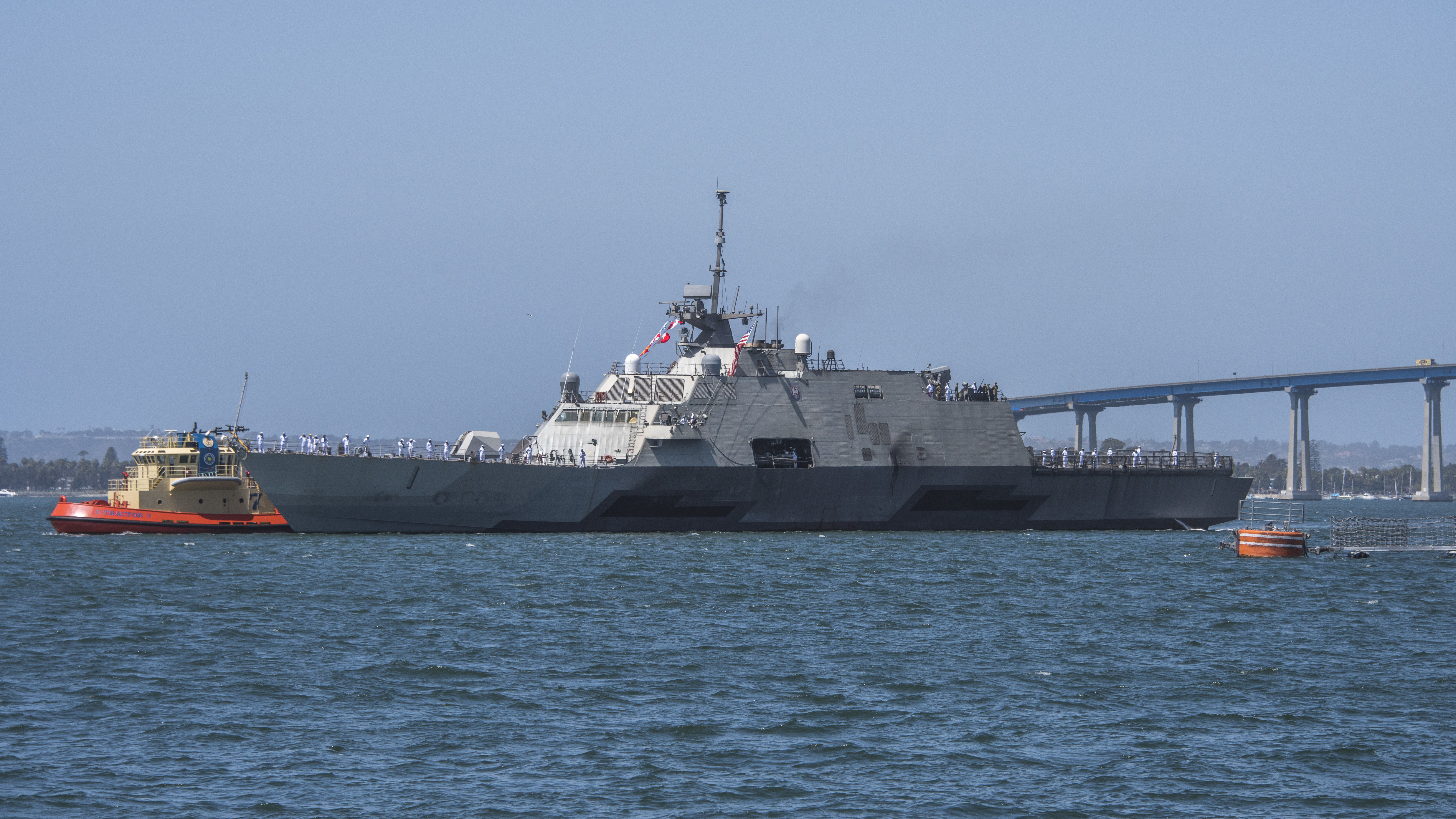
This story has been updated to include comments from the Navy’s budget briefing.
The Navy wants to cut four Littoral Combat Ships from the fleet as part of a cost-saving measure that will net the service $186 million, according to the service’s latest budget request.
The request to cull the ships from the battle force inventory comes despite criticism from Congress over last year’s proposal to retire the first four Littoral Combat Ships early.
Budget documents call for cutting the second Independence-class aluminum trimaran USS Coronado (LCS-4) and three Freedom-class variants – USS Fort Worth (LCS-3), USS Detroit (LCS-7) and USS Little Rock (LCS-9) – that have struggled with problems with their propulsion systems.
The Navy commissioned Forth Worth in 2012 and Coronado in 2014. Detroit commissioned in 2016 and Little Rock in 2017.
The Pentagon and the Navy gave two separate rationales for cutting the ships.
Cutting the pair, “avoids the cost to upgrade these ships to the common configuration and capability with the rest of the fleet and allows for investments in higher priority capability and capacity,” according to a Navy document outlining the service’s FY 2022 request. “Also, LCSs 3 and 4 do not have mission packages (MP) assigned and the current MP procurement does not account for MP procurement for these two ships. Continued fleet operations would require purchasing an MP for each ship. The replacement capability is the FFG 62 Constellation class of ships.”
The first Constellation-class frigate is not expected to enter the fleet until the late 2020s.
The Pentagon said a Freedom-class wide issue with the combining gear that marries the ship’s gas turbines to the diesel engines on Detroit and Little Rock weren’t worth the effort to repair.
“LCSs 7 and 9 have experienced major propulsion train casualties (known combing gear issues) and will incur significant associated repair costs. Decommissioning these two ships includes a cost avoidance strategy, so that scarce maintenance funding can be allocated to the highest priority ships. The replacement capability is the FFG-62 Constellation class of ships,” reads the FY 2022 Pentagon budget highlights book.
Explaining the reasons for decommissioning Detroit and Little Rock, Rear Adm. John Gumbleton, the Navy’s deputy assistant secretary for budget, during a Friday briefing noted that USS Milwaukee (LCS-5) is gearing up for a deployment.
“So as they looked at LCS – LCS-5 happened to just have a maintenance availability. We’re putting a Naval Strike Missile on it and it’s getting ready for deployment,” Gumbleton said. “And so we looked at, for the total of four to reinvest those funds across the [Future Years Defense Program] and [LCS-]7 and [LCS-]9 were the most suitable ships for that reason.”
While the Navy has sought to justify its plans to decommission the first four LCSs early by arguing they are test platforms, the Navy bought the ships under the notion they would be part of the fleet, several sources familiar with the development of LCS have told USNI News since last year’s proposed cuts.
In the FY 2021 budget proposal, the Navy disclosed its intention to mothball the first four LCSs – USS Freedom (LCS-1), USS Independence (LCS-2), Fort Worth and Coronado – arguing it would save the service money it could then invest in new capabilities.
Chief of Naval Operations Adm. Mike Gilday has argued that because the first four hulls are not in the same configuration as the rest of the ships in the class, the Navy would need to invest a significant amount of dollars to update them.

“We used those first hulls to test and we put no money into upgrading them like the rest of the fleet. So in order to put them on the same par as the rest of the LCS class, it would cost about another $2 billion over the FYDP,” Gilday said in March 2020 of the proposal to decommission the first four LCSs.
“So that was a tough decision to make on whether we wanted to put that money towards those existing LCSs or retire them, move on with the rest of the class, and then take that $2 billion and put it in the [shipbuilding] account for different capability.”
Earlier this month, Gilday said it would cost approximately $2.5 billion to upgrade the first four hulls to prepare them for combat.
The service has already set decommission dates for the first two hulls – Freedom and Independence. Independence will decommission on July 31, while Freedom will decommission on Sept. 30, USNI News previously reported. The Navy commissioned Freedom in 2008, meaning it will have served 13 years when it leaves the fleet. Independence commissioned in 2010 and will have served 11 years when it’s decommissioned. The LCS hulls were expected to each have a 25-year service life.
While Independence has never deployed and served as a test platform, Freedom recently deployed to U.S. Southern Command. Fort Worth and Coronado have each deployed once, but both experienced technical issues that forced repairs during their deployments.
Fort Worth and Coronado were part of the original quartet of LCS the Navy acquired ahead of the competition for the final designs. While Coronado is an Independence-class LCS, the remaining ships on the Navy’s decommission list for FY 2022 are Freedom-class hulls built by Lockheed Martin.
The latest proposal will likely meet opposition in Congress, which last year stopped the Navy from decommissioning Fort Worth and Coronado.
Lawmakers last year criticized the original proposal to mothball the first four LCSs. Rep. Elaine Luria (D-Va.), a former nuclear-qualified surface warfare officer who became the vice chair of the House Armed Services Committee earlier this year, balked at the proposal to decommission the early ships and the service’s struggle to understand how it would use the LCS platform.
During a heated exchange last year with former acting Navy Secretary Thomas Modly, Luria questioned the Navy’s acquisition approach to the LCS.

“I just wanted to point out the fact that, you know, we’ve had class after class after class of ship procurement and construction that has essentially failed. And it’s failed us in providing national defense, presence, deterrence overseas,” Luria said during a Congressional hearing in February 2020. “And it’s failed the sailors who are working on those ships. They’re the ones who are doing the right thing, but we’re giving them platforms that can’t do the job, that are not fully developed, that are not mature in design before we start building them.”
“We’re going to go through and we’re going to start decommissioning them when the oldest one is 12 years old,” she added of the LCS. “And I’ll quote Adm. Gilday, gave I think a good assessment of what they turned out to be . . . that they were just prototypes because we built them and then we figured out that they didn’t work. So, is this like a ‘we’ll build it and then they’ll come’ mentality that the Navy has?”
Modly at the time described the first two hulls – which were purchased using research and development funds – as ships that were never meant to be operational.
“Is that what was testified to Congress?” Luria asked Modly during the hearing. “When you came and ask us to pay a bill and the American taxpayer to pay for ships, you’ve told us you wanted to build two ships that weren’t going to be operational, that were never going to deploy and then you send sailors there and expect them to operate these and put all of their blood, sweat and tears into operating these ships that are never going to deploy?”
Modly at the time argued that they were research and development vessels due to how they were funded, but confirmed to Luria that the first two hulls are included in the Navy’s current inventory of battle force ships and were operational ships in the fleet.
“The LCS – the first two LCS ships were not designed to be operational ships. They were test ships,” Modly said at the time.
While the LCS has struggled to find its stride amidst a series of technological issues with the Freedom-class and delays to the Mission Package, the desire to mothball the early hulls comes as combatant commanders have recently turned to the ships to perform region-specific missions.
U.S. Southern Command has used the ships to conduct anti-drug operations in its area of responsibility. Freedom and Detroit have both performed counter-drug missions in SOUTHCOM within the last year and Little Rock’s first deployment in 2020 was to SOUTHCOM.
Meanwhile, commander of Naval Surface Forces Vice Adm. Roy Kitchener earlier this year said the Navy was evaluating the potential to use LCS for naval forces’ Expeditionary Advanced Base Operations (EABO) – a concept that could be employed in any region, but that the services are currently experimenting with in the Indo-Pacific region – and Littoral Operations in a Contested Environment (LOCE).

“I talk a lot with [U.S. 7th Fleet Commander Vice Adm. Bill Merz] out here, a big fan of LCS. If you look at the things we want to do in the 7th Fleet warfight, and you look at LOCE (Littoral Operations in a Contested Environment) and EABO and things like that, that’s what he wants to use them for,” Kitchener said at a January conference. “And there’s a lot of capability there. Every LCS now is getting NSM, the (naval) strike missile, so that’s a capability that we’re really excited about. … In the fight out here, that’s exactly what we’re looking at, is integrating there in the littoral, bringing that strike capability.”
Speaking at a conference this week, Merz made a case for using the LCS in the Indo-Pacific region. He pointed to USS Gabrielle Giffords (LCS-10), which was deployed in the Pacific last year and has test fired a Naval Strike Missile, and said the Navy is committed to outfitting every LCS in the region with that weapon.
“Gabby pretty much owned the southern South China Sea when I had [USS Theodore Roosevelt (CVN-71)] down… with COVID,” Merz said, referring to the COVID-19 outbreak aboard the carrier in the early days of the pandemic. “She just kept out there pounding away, blowing up every Chinese operation. It was pretty impressive work.”
While the latest budget proposal shows the Navy for the second year in a row attempting to retire LCSs, Congress will ultimately have the final say.
The final FY 2021 appropriations bill prevented the Navy from decommissioning Fort Worth and Coronado, but did not include a stipulation for Freedom and Independence, paving the way for the service to decommission the first two hulls.
Rep. Rob Wittman (R-Va.), who is the vice ranking member of the House Armed Services committees and the ranking member of the seapower and projection forces subcommittee, and Luria have both recently said they don’t support the Navy’s divest-to-reinvest approach for ships.
“I just feel like this divesting is divesting of capability, leaving gaps where combatant commanders have needs, and we just need to use what we have where we can use it,” Luria told USNI News in a recent interview.





